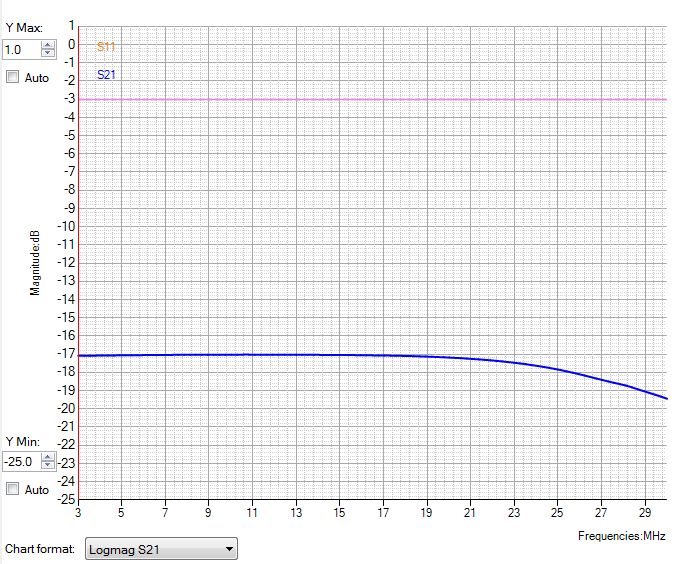Does EFHW Efficiency Matter?
If you go looking at common and popular designs for EFHW UnUns on the internet they mostly follow the same general formula.
You put a 2 turn bifilar primary winding onto a toroid and a 14 turn secondary so you get a 49:1 impedance transformation. The turns are spread out and there is a crossover at about the 7th turn.
Then you put a “blue” cap of some kind across your primary and connect that to you coax. This would account for 95% or more of the designs I’ve seen, and for YouTube and also for the ARRL kit as well.
interestingly you’ll see this same design applied to toroids from 0.5 inch FT50 size up to the largest common toroids of the FT240 size. The turns ratio is not adjusted, nothing, it is all the same one size fits all despite each toroid having different properties.
If you look around you’ll find some SWR curves and even some real time videos of SWR measurements on RigExpert or other analyzers. So it must be good <droll sarcasm>. Right? I mean, if you have a 1:1 SWR then how can the design be anything other than brilliant?
Then, if the ARRL publish a design then it must be good, right?
But the real world is different. SWR is a poor indicator of how well your antenna system works. I’ll keep saying this “a dummy load has a great SWR.”
In the screen grab image above this is an S21 through loss plot from a nanoVNA. It plots how much signal is passed through the device in question. Now, -17db might look terrible for a S21, through loss, measurement. It is an incredible loss if it was truly 17dB of actual loss!
But that’s not the case. just the opposite. This S21 was read from a resistive termination on the output of the UnUn under test and is for a 49:1 impedance transformation.
We expect -16.9dB – so -17dB is actually 0.1 dB of loss. This is an efficient UnUn with such a low loss.
As with all such published measurements, there are issues with this simple measurement when you try to apply it to the real world – and I’ll go over them later.
But one HUGE point is that it is a published result. You can see it. You can say “wow the loss at 80m is so low” then you can think about the 10m performance and why that is so different.
But at least you know.
Treating Amateurs as, well, Amateurs!
This irritates the hell out of me.
Surely we as users in a technical hobby have the right to assume that the things we purchase or the designs we follow have in fact some basis in a performance measurement and quiality we would hope was acceptable.
We are a well connected group, through radio and forum posts, in a hobby that does foster learning, experimentation and also some measure of quality.
Yet in my experience this is often not the case. We take many things for granted.
Just This Week
I’ve been developing a new product. It is in a cylindrical form, handles 100 Watts and uses a very efficient UnUn design I know works well. It will be a “classic UnUn” – not a hybrid.
Well I saw an extremely similar device on YouTube, a cylindrical UnUn. It looked really quite good, was for sale, and had some great claims as to performance.
Well I saw how it was built. It has a single core, an FT82-43 it looked like, a bifilar 2 turn primary and 14 turn secondary.
In late 2021 and without great effort I tested this build method using a nanoVNA and the efficiency was surprisingly low.
On 3.5mHz it was 31% – WOW – so you lose 70% of your power in core heating. Mind you, the efficiency rises to a sarcastically massive 60% at around 28mHz.
The only way to know is to test
OZ-Tenna products are tested in 3 ways.
The initial design is tested using a VNA. We do an S21 through loss measurement and from that broadly know how the device under test will perform in the field.
This test is somewhat indicative of real world performance. No antenna is even vaguely purely resistive across HF.
But at least we are testing it. We can do comparisons with numbers.
The second test is to put digital power into the UnUn when it is connected to an antenna, then measure heat rise and from that calculate loss.
The last test is to measure SWR across the bands. Generally this will show similar results unless the UnUn or the antenna are wildly different.
One thing the SWR test does show is how effective the 1:1 balun is in a hybrid UnUn. The more the 1:1 “isolates” the UnUn from the coax, the more the UnUn relies on radials.
So What Happens To The Lost Power?
It’s turned into heat in the ferrite core.
If you get the core hotter than maybe 100C or a little more, you run the risk of permanent damage, maybe shattering the core.
For SSB which has a low average power, you can get away with using quite a lot of power with inefficient cores. For example, if you use 100W SSB, this can be the equivalent of 5W ot 10W of digital power.
For digital modes it is much more serious. If you use even 10W of digital mode power, that has a 100% average power and then that can cause extreme heating in small or inefficient cores.
The moral of this is that a rating in SSB can be 10 times that of digital. So a 100W SSB rating means that 10w digital mode may well have the same average power – or more.
